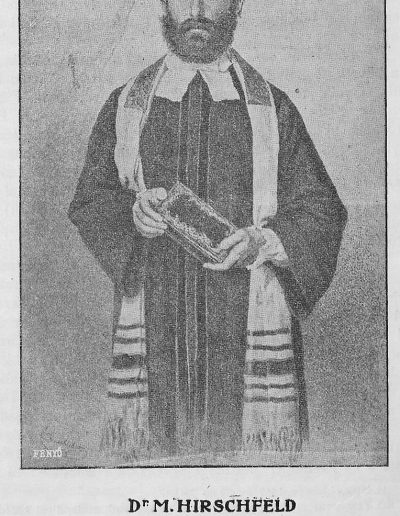Hirschfeld Mór (Moritz)
1819, Sasvár, today the Slovak Republic - 1913, Vienna, Austria-HungaryRabbi
He studied theology in Berlin, then medicine for a short time and studied Talmudic in Vienna. In a memorable speech in response to an anti-Semitic stance, he uttered a phrase that will often be quoted: “Nimmermehr kann der Christ Christ sein, ohne Mensch zu sein, wenn auch der Mensch Mensch sein kann, ohne Christ zu sein. ‟(A Christian can never be a Christian without being a man, while a man can be a man without being a Christian.) As a rabbi in Moravia (now the Czech Republic), he founded a Torah Talmud school.
On December 2, 1862, he was elected rabbi of the Jewish community in Timisoara. It represented the reformist current in Judaism, which had more and more followers in Timisoara. He served the two synagogues in the Citadel ̶ the Ashkenazi and the Sephardic.
He proposed the construction of a synagogue on 185-186 Erzsébet Street (today Mărăşeşti Street), because the "German" Ashkenazi synagogue from the Jewish quadrangle Judenhof, where the Community headquarters is currently located, with entrance on Gheorghe Lazăr Street no. 5 and from Mărăşeşti street, it had become too small. The project was realized thanks to the commitment of the industrialist and patron Ignátz S. Eisenstädter of Buziaş and of a very active and enthusiastic committee. Hirschfeld has repeatedly called on parishioners to support the project through donations. At the inauguration of the Synagogue on September 19, 1865, which was attended by the entire population, Rabbi Hirschfeld delivered a speech that impressed everyone. Another famous speech was given on the occasion of granting Jews equal rights in 1868.
In 1865 he founded the Alliance Israélite Universelle branch in Timişoara to strengthen the social and cultural position of Jews internationally. In May 1872, Franz Joseph I, Emperor of Austria and King of Hungary, Croatia and Bohemia, visited the synagogue, where he was received by Rabbi Hirschfeld. In honor of the illustrious visitor, the synagogue was reopened.
During his rabbinate, in 1870, the communities of Fabric and Iosefin were separated from the community of Citadel, a consequence of the division of Judaism into different currents: the Orthodox current and the neologism, to which was later added the current status quo ante. The immediate consequence was a significant drop in the community's income, which was no longer able to pay the rabbi's salary. Mór Hirschfeld was forced to leave Timisoara in 1872. He settled in Vienna, where he prospered as a stockbroker.
Sources
- Dr. Jakab Singer, Temesvári Rabbik a XVIII és XIX-ik században. Wieder Jakab Könyvnyomdája 1928
- Marie-Theres Arnbom, Damals war Heimat: Die Welt des Wiener jüdischen Grossbürgertums, 2014, Amalthea
